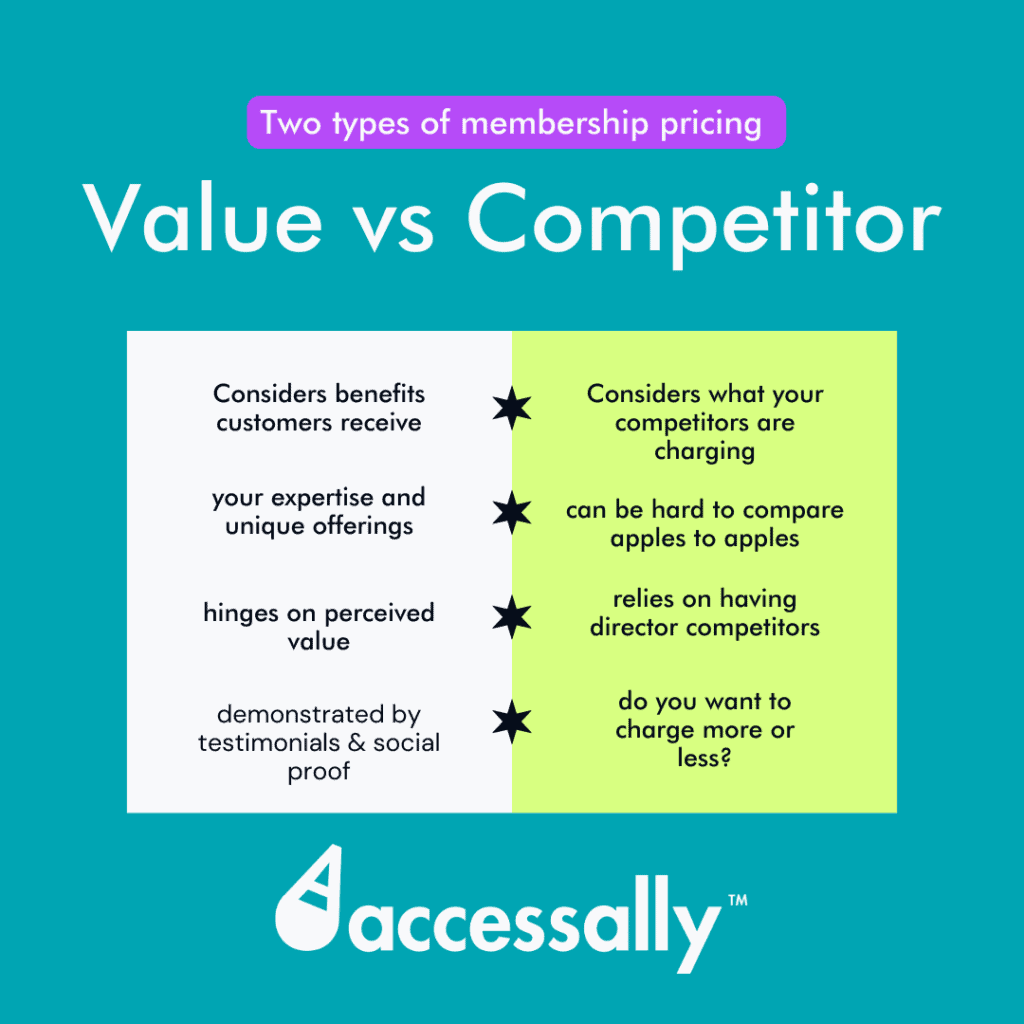A membership site is a wonderful way to create recurring revenue streams for your business and provide ongoing access to content or support for your customers. But in order to be successful, you have to have a solid membership pricing strategy for your offer.
A membership pricing strategy is the plan for how much and how frequently you will charge for your membership.
Remember: a membership is different from a subscription. Membership websites prioritize building a community and offer exclusive benefits, while subscription sites focus on providing unlimited access to a core product or service (like Netflix and Spotify or physical product subscriptions like Fab Fit Fun). Membership websites can involve a one-time fee or recurring fee, while subscriptions are always recurring payments (monthly/yearly).
Setting the right pricing strategy for your membership site can be arduous, but it is crucial because it will help you attract and retain more members. You have to find the sweet spot between what is enough for you and what your customers are willing to pay.
Your membership pricing strategy should feel like a win for both you and your members.
In this article, we’ll discuss the different types of membership pricing strategies, types of pricing models, and how to set your own pricing.
What Is a Membership Pricing Strategy & Why Is It Important?
A membership pricing strategy is how membership sites determine the right price for their membership program. It’s the plan you will create to determine the fee structure to access your site and it involves carefully considering several key factors to arrive at the pricing options that can attract the right mix of members while delivering enough value and being profitable to run as a business.
You will need to plan the amount you’ll charge, the frequency of payments, and the benefits your members will obtain. Various factors will influence your pricing model, including assessing the value of your content, estimating the size of your membership, and determining the privileges you want to offer to your members.
It’s crucial to carefully strategize your membership pricing, considering a delicate balance between revenue aspirations and the perceived value of the content and benefits offered to members. Also explain why and how a pricing strategy is important, since it has an impact on growth and retention.
2 Types of Membership Pricing Strategies
Your pricing strategy dictates what customers will pay for memberships, and there are 2 primary membership pricing strategies:
- Competitor-based pricing
- Value-based pricing.


Value-Based Pricing
Value-based pricing is about understanding what your audience is willing to pay for the value you’re offering. As the name already mentions, this pricing is based on the wide range of experiences, knowledge, etc that you are offering to your customer base.
Using a value-based pricing strategy for your membership takes into consideration the benefits members receive from subscribing to your content or services.
When pricing your membership, you should consider the expertise and the unique offerings you’re bringing to your members.
Social proof and positive feedback are ways to demonstrate that value to potential members.
When setting your price, you should consider the added value members receive with a paid subscription, such as certifications or skill enhancement.
Value-based pricing lies at the heart of maximizing profits for your membership program. It hinges on the perceived value that members attribute to the offerings you provide, making it a powerful strategy to adopt.
Competitor-Based Pricing
Competitor-based pricing takes into account how your competitors are pricing their memberships.
It involves analyzing competitor pricing and market trends to determine typical membership fees. When your audience size is too limited to conduct a comprehensive survey, the competitor-based pricing strategy emerges as an excellent starting point. By studying your competitors’ pricing models, you can gain valuable insights into the market dynamics and position your own membership pricing competitively.
You can conduct competitive research to understand the pricing structures and content offerings of similar membership sites. Or you can engage with prospective customers through surveys to gather insights into their pricing preferences.
5 Main Pricing Models for Your Membership Site
Once you choose value or competitor-based pricing, you’ll need to choose a pricing model — the “execution” or “how” of your pricing strategy — which may also be influenced by your membership model.


1. Fixed Pricing
Fixed pricing is one of the most common pricing models for membership sites. It’s when you charge a consistent, recurring fee, typically on a monthly, quarterly, or yearly basis.
This model ensures a steady cash flow for the business by providing offerings at a stable rate. With this model, examining the renewal rates of your members helps you know if your members continue to find value in their membership.
Pros:
- Simplicity: Fixed pricing is straightforward for both the business and the customers. There’s no need for complex calculations or decision-making on the customer’s end.
- Predictable Revenue: With fixed pricing, businesses can more accurately predict their monthly or yearly revenue since the income is consistent from each member.
- Easy Budgeting: Customers find it easier to budget for a fixed price membership since they know exactly how much they’ll be spending each month or year.
- Perceived Value: Depending on the pricing point, a fixed price might convey a sense of value, especially if the price is set lower than the perceived value of the services or content offered.
- Inclusive: Fixed pricing can attract a wide range of customers, as there’s no uncertainty about costs or hidden fees.
Cons:
- Potential for Overpayment: Some customers may feel they’re paying for services they don’t fully utilize, leading to a sense of overpayment.
- Limited Pricing Flexibility: Fixed pricing doesn’t allow for adjustments based on individual customer needs or market conditions. This lack of flexibility can be a disadvantage in a rapidly changing market.
- Limited Upsell Opportunities: With a fixed price model, there may be fewer opportunities to upsell additional services or premium features since customers expect everything to be included in the set price.
- Difficulty in Adjusting to Customer Preferences: If the business needs to change its offerings or adjust the pricing structure based on customer feedback or market demand, it may be challenging to do so with a fixed price model.
- Perception of Lower Value: Depending on the industry and target market, some customers may perceive a fixed price membership as offering lower quality or value compared to a variable pricing model.
2. Tiered Pricing
Tiered pricing is different from fixed pricing because each tier offers different features/perks. Usually each level of pricing includes an increasing number of perks.
This model enables you to upsell members and incentivize their progression to higher membership tiers gradually.
You should be careful not to propose too many tiers, which can get confusing for customers.
Pros:
- Flexibility: Tiered pricing offers different levels of service or features at varying price points, allowing customers to choose the option that best fits their needs and budget. This flexibility can attract a wider range of customers.
- Scalability: Businesses can cater to different customer segments by offering multiple tiers, accommodating both budget-conscious customers and those willing to pay more for additional benefits or features.
- Upselling Opportunities: Tiered pricing provides opportunities for upselling by enticing customers to upgrade to higher tiers to access more advanced features or premium services.
- Perceived Value: Customers may perceive higher-tiered plans as offering greater value, even if the actual cost-to-service ratio remains relatively consistent across tiers. This perception of value can justify higher price points and increase overall revenue.
- Revenue Optimization: Tiered pricing allows businesses to capture value from customers with varying willingness to pay, maximizing revenue potential compared to a one-size-fits-all pricing model.
Cons:
- Complexity: Managing multiple tiers can add complexity to pricing structures, potentially confusing customers and making it more challenging for them to choose the right plan.
- Decision Paralysis: Too many options can overwhelm customers, leading to decision paralysis and potentially driving them away from making a purchase.
- Customer Segmentation Challenges: Determining the appropriate features and price points for each tier requires a deep understanding of customer needs and preferences. Incorrect segmentation or pricing can lead to dissatisfaction or lost sales.
- Customer Churn: If customers perceive that they’re not getting sufficient value from their chosen tier, they may downgrade to a lower tier or cancel their subscription altogether, leading to increased churn.
- Price Comparison: Customers may spend more time comparing different tiers and prices, potentially leading them to choose a lower-priced option than they would in a simpler pricing model.
3. Freemium
This model features free and premium membership options: basic services are free while enhanced features require a payment. It’s similar to a tiered pricing model, but the freemium model establishes a lower entry barrier for customer engagement and attracts a larger user base with free offerings.
Pros:
- User Acquisition: Freemium models can attract a large user base by offering a basic version of the product or service for free. This can be particularly effective for startups or new products looking to gain traction and market share.
- Product Awareness: Offering a free version allows users to try out the product or service without committing to a purchase. This can increase brand awareness and generate word-of-mouth marketing as satisfied users recommend the product to others.
- Upselling Opportunities: Freemium models provide opportunities to upsell premium features or services to users who find value in the free version and are willing to pay for additional functionality or benefits.
- Reduced Barrier to Entry: By offering a free version, businesses lower the barrier to entry for potential customers who may be hesitant to pay for something they haven’t tried. This can lead to higher conversion rates and increased customer acquisition.
- Feedback and Iteration: With a large user base using the free version, businesses can gather valuable feedback and data to iterate and improve the product or service, ultimately enhancing the offering for both free and paid users.
Cons:
- Monetization Challenges: Converting free users into paying customers can be challenging, especially if the free version offers sufficient functionality for their needs. This can limit revenue potential and sustainability.
- Costs of Supporting Free Users: Providing a free version incurs costs for customer support, server infrastructure, and ongoing development, without immediate revenue to offset these expenses. This can strain resources, particularly for startups or small businesses.
- Value Perception: Free versions may create the perception that the product or service lacks value compared to paid alternatives. This can make it difficult to justify premium pricing for upgraded features or services.
- User Retention: Free users may be less invested in the product or service and more likely to churn compared to paying customers. Retaining free users and converting them into loyal, paying customers requires ongoing engagement and value delivery.
- Competitive Pressure: In markets with competitors offering similar free versions, businesses may face pressure to continuously improve and expand the free offering to remain competitive, potentially eroding profit margins.
4. Usage-Based Pricing
This model is also known as “pay as you go.” This pricing model offers members the flexibility to pay based on their content consumption or the level of service they utilize.
Pros:
- Cost Efficiency: Users only pay for the resources or services they actually use, making the pricing model cost-effective for both businesses and customers. This can be particularly attractive for customers with variable or unpredictable usage patterns.
- Scalability: Usage-based pricing scales with usage levels, allowing businesses to accommodate fluctuations in demand without overcommitting resources or capacity. This flexibility is advantageous for both startups and established businesses experiencing growth.
- Transparency: The pay-as-you-go model offers transparency in pricing, as customers can easily understand and track their usage and associated costs. This transparency builds trust and reduces the likelihood of billing disputes or customer dissatisfaction.
- Low Barrier to Entry: Pay-as-you-go pricing eliminates the need for upfront commitments or long-term contracts, reducing the barrier to entry for customers who may be hesitant to make a significant financial commitment.
- Incentivizes Efficiency: Since customers are charged based on usage, there’s a natural incentive for them to optimize their usage patterns and minimize waste, leading to more efficient resource allocation and cost savings.
Cons:
- Budgeting Challenges: While usage-based pricing offers flexibility, it can also lead to budgeting challenges for customers who prefer fixed monthly expenses. Fluctuating costs based on usage can make it difficult for customers to predict and plan their expenses accurately.
- Complexity: Managing usage-based pricing structures can be complex, especially for businesses offering a wide range of products or services with varying usage metrics. This complexity may lead to confusion among customers and challenges in pricing and billing management.
- Risk of Bill Shock: Customers may be surprised by unexpectedly high bills if they underestimate their usage or fail to monitor their usage closely. This can lead to dissatisfaction and churn if customers feel they’re being overcharged.
- Limited Predictability: From the business perspective, usage-based pricing may lead to revenue volatility, as it’s challenging to predict future revenue based on fluctuating usage patterns. This can pose challenges for financial planning and forecasting.
- Potential for Customer Disengagement: Customers may become disengaged if they perceive that they’re paying for unused or underutilized services. This can lead to churn or reluctance to engage with the product or service in the future.
5. One-Time Fee
With a one-time fee, members will make a one-time payment and retain their membership for a given period of time. It can even be a lifetime fee.
This model allows customers to receive long-term value for a single payment, appealing to those seeking maximum return on investment. The one-time fee model obliges you to find the balance between member value and long-term customer lifetime value.
The main drawback of this model is that you have to continuously acquire new customers.
Pros:
- Simplicity: One-time fees offer a simple and straightforward pricing structure for both businesses and customers. There’s no need for recurring payments or subscription management, making the purchasing process easy and convenient.
- Upfront Revenue: Businesses receive immediate revenue from customers who purchase the product or service, providing a steady influx of cash flow without the need to wait for recurring payments.
- Customer Ownership: Customers who pay a one-time fee typically own the product outright, giving them a sense of ownership and control. This can enhance customer satisfaction and loyalty, as they don’t have to worry about losing access if they stop paying a subscription fee.
- Predictable Costs: For customers, one-time fees provide predictability in costs since they know the total price upfront and don’t have to budget for recurring payments over time.
- Low Customer Acquisition Costs: Since there’s no need for ongoing marketing efforts to retain subscribers, the customer acquisition cost for one-time fee models can be lower compared to subscription-based models.
Cons:
- Limited Revenue Stream: One-time fees result in a one-time influx of revenue, which may not be sustainable in the long term, especially for businesses with ongoing maintenance or support costs.
- Limited Customer Lifetime Value: Without the opportunity for recurring revenue, the lifetime value of customers in a one-time fee model may be lower compared to subscription-based models. This can make it challenging to justify investments in customer acquisition and retention.
- Less Incentive for Customer Engagement: Since customers have already paid upfront for the product or service, there may be less incentive for ongoing engagement or usage, which can impact customer satisfaction and loyalty over time.
- Limited Revenue Growth: Unlike subscription models where revenue can grow over time as the customer base expands or upgrades to higher-tier plans, one-time fee models may have limited opportunities for revenue growth beyond the initial sale.
- Risk of Obsolescence: In rapidly evolving markets or industries, products or services sold with a one-time fee may become outdated or obsolete over time, leading to diminished value for customers and decreased demand.
💡 There are also some less common pricing models for membership sites: custom pricing, donation based, group membership, hybrid models, etc.
How Should You Set Your Membership Pricing Strategy?
To set your membership pricing strategy, you should consider the following factors:
Take Stock of Your Expenses
Consider your operational costs (office rent, staff salaries, website hosting fees, etc.) to ensure that your membership revenue will cover your costs.
You need to know your expenses to be able to determine what proportion of it you expect to be covered by your membership fees.
Look at Your Financial Goals
Keeping your financial goals in mind will help you set up your pricing strategy.
It will not be a factor carved in stone because you can’t take into account metrics like churn, but it will help you know what you want your pricing strategy to be. These goals will naturally change with time.
Understand Your Target Audience
Knowing your target audience will help you have an idea of their budget, which is a great indicator of how much you can charge. For example, if your ideal customers are moms on a budget, you can easily infer that they won’t likely be able to afford premium pricing.
Knowing your audience and your buyer persona will allow you to customize your pricing strategy to meet their requirements and preferences.
You should think about:
- The demographics of your audience
- How your audience perceives the value of your membership
- The pain points of your audience.
Research Your Competitors
Benchmarking your competitors is crucial to get the right membership pricing strategy. Think about your competitors’ prices, their promotional strategies, and their ideal customers.
Consider how you differentiate from them and how you can justify a higher price.
Think about Your Promotions & Deals
Thinking about your eventual promotions and deals is an important factor in setting up your pricing strategy.
Consider free trials, discounts, etc. that your members can benefit from. If you don’t think about discounts when planning your pricing strategy, you might not stay profitable when lowering prices to accommodate discounts. Build those discounts and promotions into your strategy.
The Membership Pricing Formula
We’ve created a framework for determining the right price regardless of the chosen pricing model.
Value x Stickiness x Confidence = Your Average Revenue Per Member
Define value
Think about how much value one member will receive from joining your membership. For example, if this person is able to resolve an issue in their marriage and avoids a costly divorce, put that number down.
If it’s corporate training that gives an employee the ability to ask for a raise worth $5,000 then put that number down.
Next, we look at where your number lands in the marketplace and within the business model of your own business.
Some business owners use memberships as a lead-in to a higher price point offering down the line, while others offer a course or service upfront and the membership is the long-term plan.
Decide if you plan to start low or high, based on where this membership sits in your product offerings. Use this to influence your “value” number down or up.
You might also want to look at the competition and pick the average price of competing memberships in your space, or alternative products that people may be comparing.
Then see if your value is higher or lower, by comparison. When it comes to pricing membership sites, you don’t want to just anchor your price based on your competitive research. It’s much better to know if you are aiming for a volume pricing model or if you want to be premium.
Define stickiness
Does your membership lend itself to a long-term relationship, or does it solve more of a short-term problem? Estimate how many months someone may stay on board to get this number.
Define confidence
The confidence factor is where you get to experiment with different ratios. For example, if you were able to bring $5000 in value, but you don’t think that employees would pay that much then adjust the confidence value down to reach a number that feels more in line with what people might pay. Calculate this number based on the percentage someone would pay of the total value that you bring. Using the $5000 value as an example, if you think someone would pay $250, then this number would be 5% or .05.
Example of this membership pricing formula in action:
Value 4000 x Stickiness 3 x Confidence 0.05 = $600 Average Lifetime Revenue Per Member
That makes your monthly membership price set to $200/month, based on this fairly high value.
Income x Number of Members = Average Revenue
The pricing sweet spot is where you have potential customers easily willing to pay your recurring payment and it feels like a no-brainer to them.
At this point, it’s a good idea to calculate how many members you need to reach your revenue goals.
Using this formula you can see that by increasing the number of members you have, your annual revenue increases in line.
Example:
Income $600 x 100 Members = $60,000 annual income from this membership site
Revenue – Costs = Your Profit Margin and Take-Home Income
Whether you decide to offer a recurring payment model or you want to offer lifetime membership options in your business is up to you.
Keep in mind that a membership business tends to do best when you can depend on regular monthly revenue, so you can cover monthly costs for running your business.
Calculating the costs of running your membership site might be hard if you haven’t started running it yet. Recurring payments allow you to forecast your income, which can give you more confidence in how you price your membership.
You may want to calculate how much you’ll be spending on membership plugins, hosting, membership website design or themes, video players, and your email marketing platform.
On top of these costs, think about any other inputs like your own time or anyone you might hire to help manage or run the membership.
You might estimate something along these lines:
Revenue $60,000 – Costs $10,000 = $50,000 net income
Beware that sometimes it can take a long time to reach your desired member goal, and you need to be willing to stick with it and keep promoting to grow your membership base.
How does one get to the point of feeling confident enough to charge these amounts?
6 Tips to Get People to Say Yes to Your Membership Pricing Strategy
Beyond picking the right price for your membership site, there are a few different ways you can encourage people to give your membership a shot.
How you name your different membership tiers matters a lot when it comes to perceived value.
If you’ve done your homework and built a membership experience that delivers on your promises, then getting people to try it can be one of the best marketing approaches out there.
1. Offering a Free Trial
You can offer a free or discounted membership trial, for a short period of time like 14 days or a full month.
The mechanics of offering a trial aren’t complicated when you have a solid membership management tool, but the psychology of a trial is where the power lies.
If you can give people enough of a taste of what’s possible when they come on board as a full-fledged member, then you’re more likely to have people stick around long term.
Sure, you might have some people take your trial and try to speed through all of your content and cancel, but the ones that see the value will be happy to pay to stay on board.
2. Yearly vs. Monthly Membership Plans
Many membership sites offer a choice of yearly or monthly membership payment plans.
The benefit to you as the site owner is that you get more cash flow upfront if someone takes the yearly option or a steadier, more predictable monthly income as your monthly members grow.
By offering both options, you can also incentivize people who are going to be there for the long term. For example, a common practice is to offer a price break on the yearly plan or to give additional bonuses for those who choose the annual payment.
A monthly option can also act as a trial for those who aren’t quite sold yet but want to give your membership a try with the ability to cancel easily.
3. Price Anchoring
If you’re offering a monthly and a yearly plan, you might also want to create a third option that is higher priced.
Why? Because having a bigger package that costs more can put the affordability of your regular membership program into perspective.
You might offer a more tailored one-to-one program that costs 10 times the price of your recurring membership. Put that option on the sales page for your membership program, and you might get people who want the premium experience to go for it.
4. Lifetime Memberships
Some membership site owners choose to offer a Lifetime Membership, where a customer will pay once and remain a member for the lifetime of the program.
This is a great move when you’re trying to figure out your membership pricing, and you don’t have a lot of members yet because you can test different price points. (It also pairs well with a founding member offer, see below!)
The downside is that it removes the recurring revenue aspect of your membership program, and if you have a small market or niche you might not be able to get in front of enough new members to make your membership sustainable without recurring income.
That’s why I recommend only offering lifetime memberships if the price is significantly higher than your average customer lifetime value, if you plan to have other products and services to sell down the line, or if your market is very big.
5. Founding Members
It helps to have real people helping you when you’re just getting your membership site off the ground. These are your founding members!
You can offer a special price (like a lifetime deal or a long-term discount) to the first few people who join your membership. How many people you accept as your founding members will depend on how big your audience is.
For example, those with a larger audience may choose to invite 100 Founding Members, while others might cap it at 30.
Founding members should get additional perks because they’re the first to dive in. That could mean additional bonuses, time with you, or better networking because the group is still small.
They will also be a great source of feedback, so be sure to listen and take their input to heart as you continue to improve and build your membership program and site.
6. Raising Membership Prices Over Time
Whether you started off with a lower price for Founding Members, or you decided to start low and raise prices over time, it’s a good idea to consider how you will do it when the time comes.
The worst thing you can do to members is to pull the rug out from under them by increasing the cost of your membership.
Instead, I recommend letting non-members know that the price will be going up before you raise it. That gives anyone who has been on the fence a chance to join and lock in a good rate.
But for existing members, it’s best not to raise their subscription prices. That’s because they’ve been there the longest, and have already paid you the most over time.
In a way, new members are paying a higher rate because of all the work and new materials you’ve added over time that has been paid for by past members.
It’s best to stair-step your pricing, as you raise your rates. This way, you get to keep testing your membership price without scaring off potential new customers. And having members at different tiers just means people are less likely to cancel because they might lose their exclusive pricing.







